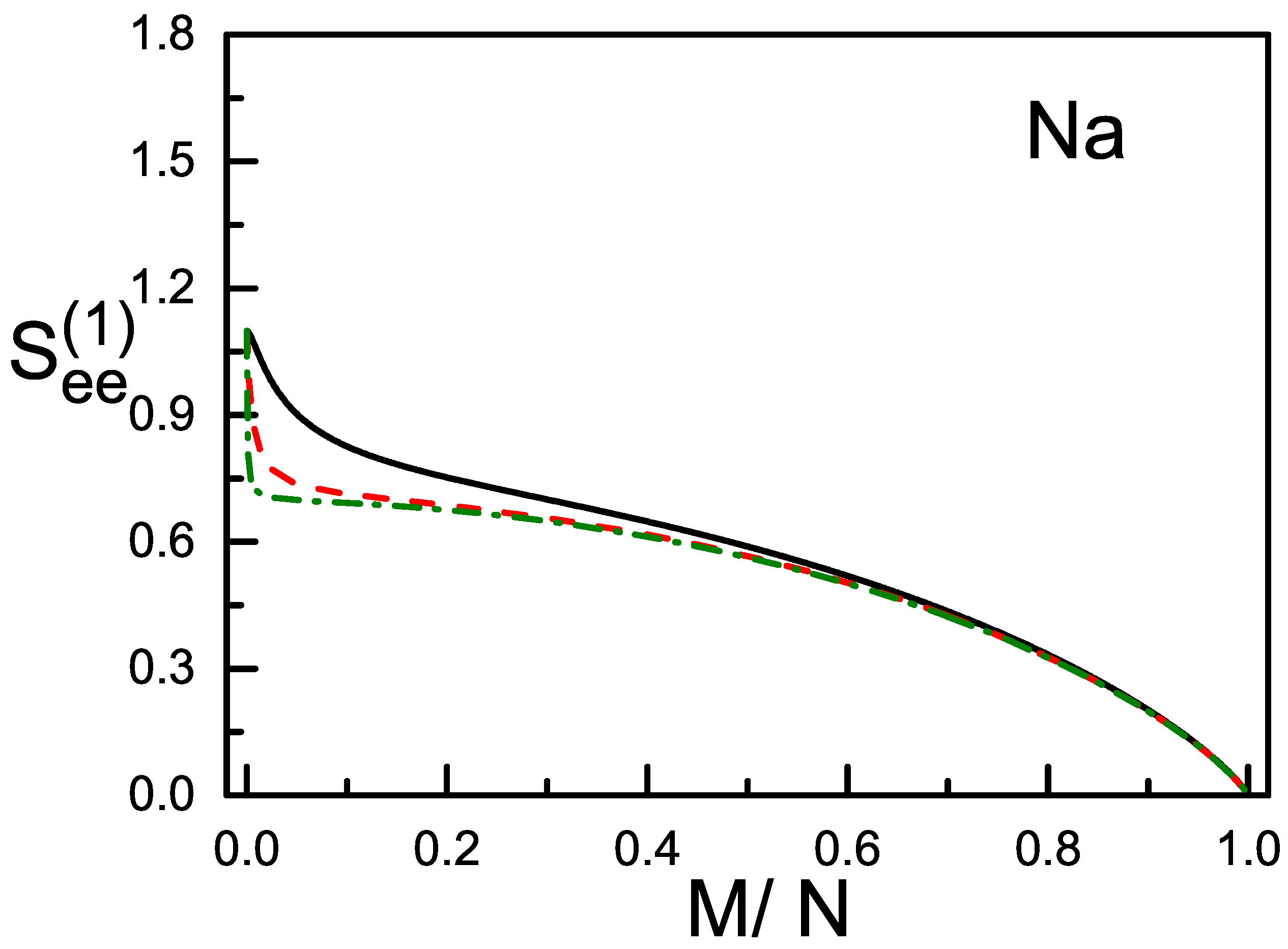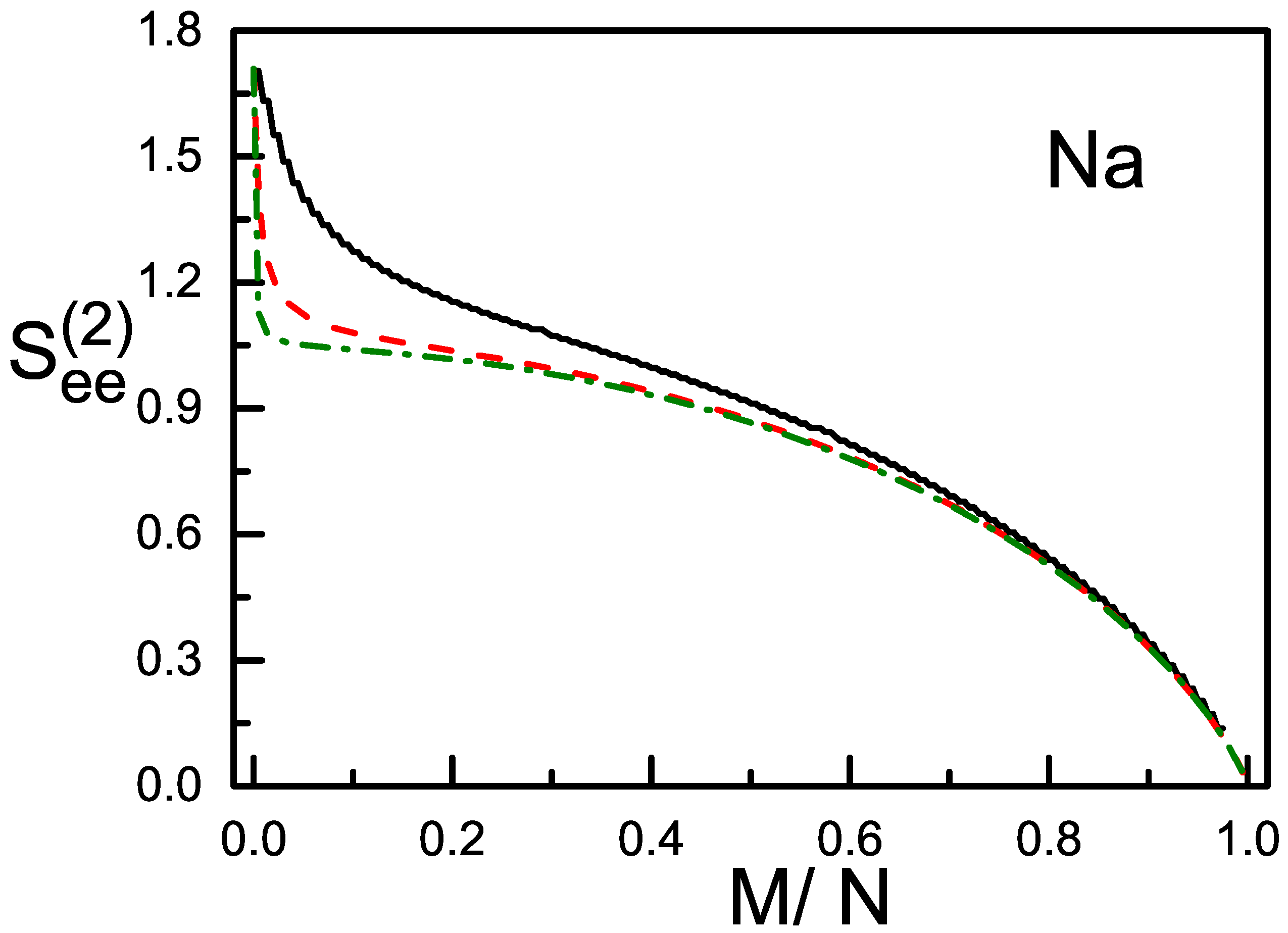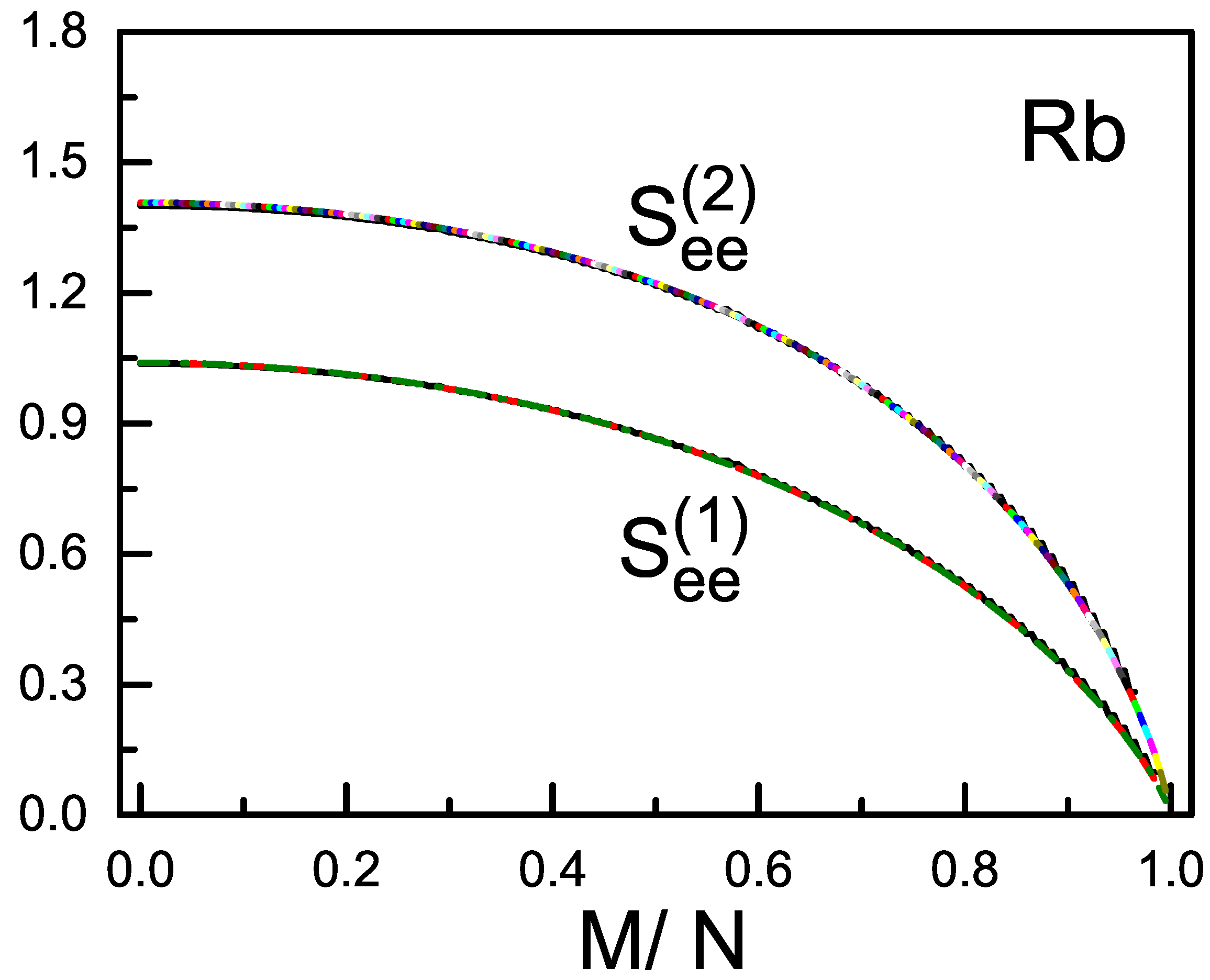1. Introduction
Entanglement is a curiosity in quantum world. This topic is not only interesting in the academic aspect, but also possesses profound potential in application (e.g., in quantum communication) [
1,
2]. On the other hand, what happens at temperature (T) zero is one of the essential focuses in physical research. Although the T = 0 limit cannot be exactly realized, the related study pointing at this limit and its neighborhood is important (i.e., the superconductivity). There are already many findings related to this limit (like the famous Third Law of Thermodynamics). Accompanying the progress in technology, lower and lower temperature (i.e., <
K) can be realized. This progress definitely will attract more and more theoretical studies aiming at the neighborhood of T = 0. Furthermore, the technology for trapping the cold atoms is one of the most important progress in physics in recent years. This technology leads to the realization of man-made systems, namely, various Bose-Einstein condensates (BEC), and opens a very broad field of research promising in application [
3,
4,
5,
6,
7,
8]. Since these man-made systems are controllable, they can be used as analogs of other many-body systems to reveal the underlying physics. When T
, the BEC will tend to its ground state (g.s.). With these in mind, this paper is devoted to studying the Von Neumann entanglement entropy (EE) of the g.s. of BEC.
Note that, in the g.s. of spin-0 BEC, the particles are not correlated, thus the entanglement is zero. However, for the g.s. of the spin-1 BEC, due to the spin-spin correlation, the entanglement is in general not zero. Previously, we have developed a tool, namely, the fractional percentage coefficients (FPC), for dealing with the complicated spin-states of the many-body systems with spin-1 particles [
9,
10]. With the FPC, one can extract the wave function of one (or more than one) particle(s) from the total wave function. Thus, the FPC works as an appropriate and powerful tool for studying the entanglement between a particle (or a few particles) and the others. Therefore, the g.s. of the spin-1 BEC are chosen to be studied in the follows. Due to the use of the FPC, the study is in an analytical way. The analytical formalism facilitates greatly related analysis.
2. Entanglement among a Particle and the Others
For the spin-1 BEC, the interaction can be written as
, where
is the spin operator of the i-th particle. This interaction conserves the total spin
S and its
Z-component
M. Therefore, a more precise theory for the g.s. should keep both
S and
M to be conserved. With this consideration the lowest state with the good quantum numbers
S and
M can be assumed as
where
is the normalized all-symmetric total spin state with the given
S and
M, and
N is the particle number,
S is ranged from 0 to
N. According to the theory given in [
11],
must be even and the multiplicity is one (i.e.,
is unique for
S and
M).
is the spatial wave function of the
i-th particle. All the particles are condensed into this state which is most favorable for binding.
When
N is large the general expression of
is very complicated. For two particular cases
and
,
is given as an expansion in terms of the Fock-states [
5]. Nonetheless, due to the introduction of the FPC, the explicit form of
is irrelevant. One can extract a spin from
as [
9,
10]
where
is the spin-state of the particle
i in
component,
. All the other particles are contained in
,
and
are the FPC deived in [
9,
10], they appear as
where
are the Clebsch-Gordan coefficients for spin-coupling.
We consider the
i-th particle as the A-system, while the other particles as the B-system. Recall that the A-system contains three base functions
, where
, and the B-system contains six base functions
. Starting from Equation (
2), it is straight forward to obtain the reduced density matrix
where
3. Entanglement among a Pair of Particles and the Others
Using the FPC once again to extract one more spin from
, Equation (
2) can be rewritten as
where the
i-th and
j-th spins in
have been extracted. The FPC are
All the other are zero. Furthermore, when , and should be zero.
We consider the
i-th and
j-th particles as the A-system, it contains six basis functions
, where
and 2,
m is the Z-component of
s. The others belong to the B-system, it contains fifteen basis functions
, where
and
S. The reduced density matrix is
where
. The matrix elements of
with respect to the basis functions
is
When
and
, both
s and
must equal to 2, thus only the diagonal matrix elements survive. However, when
, both
s and
can be 0 and 2. Accordingly, we have
After a diagonalization, we obtain the two diagonal matrix elements as
From the diagonal elements, the EE is
In the summation , m runs over only and .
4. Numerical Examples
We consider the condensates with both the total spin
S and its Z-component
M being conserved. Thus the magnetic polarization
is conserved and depends on how the condensate is prepared. When
(e.g.,
23Na), a pair of atoms prefer to have their spins anti-parallel, and the total spin-states with a smaller
S will have a lower energy. Accordingly, the g.s. has either
(when the magnetization is zero, in this case the g.s. is purely composed of the
pairs if
N is even), or
(when the magnetization is non-zero). The g.s.
is called to be in the polar phase. When
N is given at 10
2, 10
3, and 10
4,
and
of the g.s. in polar phase are plotted in
Figure 1 and
Figure 2, respectively, against
. On the other hand, when
(e.g.,
87Rb), a pair of atoms prefer to have their spins parallel, and the total spin-states with a larger
S will have a lower energy. Accordingly, the g.s. has always
disregarding how the magnetization is. In this case the g.s. is in ferromagnetic phase. The
and
of the g.s. in ferromagnetic phase are plotted in
Figure 3.
We found the following features (under the condition that the spatial degrees of freedom are frozen):
(i) In general . In particular, when (zero polarization), for the g.s. in polar phase, ; when . For the g.s. in ferromagnetic phase and when , and . It is expected that, when more particles are included in the system-A (but ), the EE would be larger. This is a point to be confirmed.
(ii) Both and decrease with the increase of polarization and they tend to zero when (fully polarized). When the condensate is fully polarized, all the spins are not free. Thus the vanish of the entanglement when is obvious.
(iii) and of the g.s. do not depend on the strengths of the interactions but only on the sign of the spin-dependent interaction (i.e., either attractive or repulsive. The former leads to the ferromagnetic phase while the latter leads to the polar phase). They also do not depend on the trap.
(iv)
and
depend in general weakly on
N. This is particularly true for the ferromagnetic g.s. as shown in
Figure 3, where the three curves for different
N overlap nearly. However, for the g.s. in polar phase and when
increases from zero, a sudden fall of
and
is found. The fall is extremely steep when
N is very large (e.g.,
) as shown in
Figure 1 and
Figure 2. It will become steeper when
N becomes larger (compare the left parts of the dash and dash-dot curves in
Figure 1 and
Figure 2). There is a turning point, when
exceeds this point, the steep fall will be replaced by a gentle descent and tends to zero as mentioned. Usually, the condensates have a large
N. Thus, for the polar g.s., there is a narrow and highly sensitive region when the polarization increases from zero. In this region the structure of the g.s. (measured by the ratios of the numbers of
μ-atoms
) is highly sensitive to the polarization (refer to Figure 3 of the ref. [
12]). In fact, when
and by using Equation (
2), it is straight forward to obtain that all three
. Recall that, when
and
N is large, a small increase in the polarization will cause a large increase in
S. Thus the factor
leads to the appearance of the turning point.
5. Discussions and Final Remarks
General expressions for the bi-partite entanglement entropies of one atom and the others, as well as a pair of atoms and the others, in the ground state of spin-1 BEC are derived. Numerical examples for the condensates in polar phase and ferromagnetic phase are given. It is shown that, when the condensate has a large
N, the two entanglement entropies of the g.s. in polar phase drops sharply when
increases from zero. On the other hand, the two entanglement entropies of the g.s. in ferromagnetic phase are almost independent of the atom number and decreases smoothly with
. Note that, when
, the total spin-state is purely composed of the
pairs (if
N is even, otherwise, one particle is not in a pair). While when
S increases, more and more
pairs will mix in. For the polar g.s. with a large
N, a small increase in
will lead to a big increase in
S (because
) and therefore cause a great change in spin-structure (refer to the
law mentioned above). This responds to the big fall appearing in
Figure 1 and
Figure 2 when
. Whereas for the ferromagnetic g.s., the increase in
will not change
S (because
S remains
). Thus the structure of the total spin-state remains unchanged but only its geometry. This responds to the smooth and monotonic variation as shown in
Figure 3.
Note that, when only spin-degrees of freedom are concerned, both Equations (
6) and (
13) are exact analytical expressions for the EE of the systems. For spin-1 atoms, the spin-independent interaction is nearly two order stronger than the spin-dependent interaction. Therefore the spatial excitation energy would be in general much higher than the spin-excitation energy. Accordingly, when the temperature is sufficiently low, the spatial excitation would not be involved and the spatial degrees of freedom could be considered as being frozen [
13]. In this case, the EE are exactly given by the above two formulae.
The entanglement of many-body systems is tightly connected to the characteristics of phase diagram and other thermodynamic quantities [
14,
15]. The present paper has concentrated on the entanglement of internal degrees of freedom of the system in the zero temperature limit. Exploring the effect of spin-orbital coupling, including spatial excitations, would be interesting future work.






